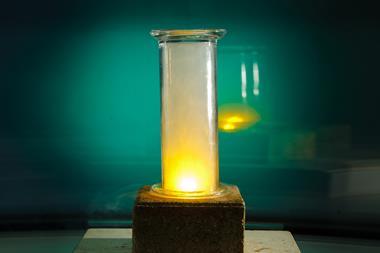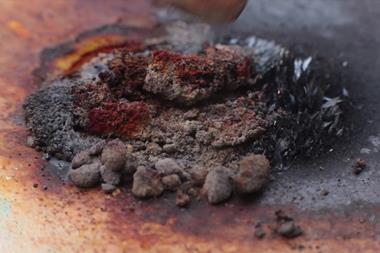As part of a multi-lesson practical, my students heated samples in boiling tubes. I’d handed out sticker labels for students to name their tubes and a perplexed girl came to share her frustration at her writing disappearing. She wrote her name on the sticker, applied it to the tube and then moments later it had vanished.
She’d used a Pilot ‘FriXion’ pen and I realised the boiling tube’s heat must have made the ink disappear – it was thermochromic ink. FriXion pens are designed so you can erase mistakes by rubbing with the integrated eraser. The heat generated by the friction between rubber and paper causes the ink to heat up and go colourless.
This thermochromic change at around 60 °C is easily reversed at -5 °C and I’ve since found numerous uses for this ink in binary temperature labels. For example, you can use it to demonstrate the differences in microwave absorption by polar and non-polar solvents. Another idea is to use thermochromic inks to demonstrate the speed of light.
This thermochromic change at around 60 °C is easily reversed at -5 °C and I’ve since found numerous uses for this ink in binary temperature labels. For example, you can use it to demonstrate the differences in microwave absorption by polar and non-polar solvents (rsc.li/2vf7BUl). Another idea is to use thermochromic inks to demonstrate the speed of light.
Kit
- Thermochromic pens
- Microwave oven
- A3 paper
In front of the class
In the classic microwave oven demonstration to determine the speed of light, you remove or invert the oven’s rotating base plate and put a plate of food, like marshmallows or chocolate, within to heat.
The standing wave set up in the oven cavity has nodes where no heating occurs, and antinodes where substantial heating takes place. In the normal function of an oven, food is rotated through these hot spots to ensure even cooking. Without rotation, the food melts only at an antinode.
You can measure a wavelength as the distance between melted patches. The operational frequency is quoted on the back of the oven. Using wavelength and frequency, you can calculate the speed of light.
Students get tasty rewards for participating, but there are a number of issues with this version of the demonstration; a round plate is placed in a rectangular space, there’s conduction through the food, and absorbance changes as food melts causing the wave in the cavity to shift. Marshmallows usually give two major patches of heating and some hand-waving is needed to justify whether measuring the distance between them represents one antinode to the next or a full wavelength.
Instead, take an A3 sheet of paper and scribble over it with thermochromic ink. Trim it to the exact size of the cavity and heat (5–10 seconds in a 1200 W oven). The thermochromic ink very clearly resolves the waveform with multiple measurement points available, sometimes with centimetre resolution.
The output is rendered immediately onto paper, so you can hand it out to groups of students (with photocopies if needed).
Teaching goal
From the microwaved ink on paper, students can make their own measurements. They can record minimum and maximum values for their speed of light using appropriate significant figures, and from multiple places on the waveform. They can take an average before comparing with an accepted value. For me, this reinforces differences between accuracy and precision, and random and systematic errors at a time in a post-16 course when I want to emphasise them.
There’s also the chemistry behind the colour-changing ink. The ink in thermochromic pens is a pH-sensitive diaryl or triaryl phthalide, similar to phenolphthalein or crystal violet, or other leuco dyes (dyes that can switch between colourless and coloured chemical forms). The ink can interact with a weak acid (a ‘developer’) such as a phenol – we can demonstrate this interaction by showing that 1 M HCl decolourises the ink but 1 M NaOH has no effect.
There’s also the chemistry behind the colour-changing ink. The ink in thermochromic pens is a pH-sensitive diaryl or triaryl phthalide, similar to phenolphthalein or crystal violet, or other leuco dyes (dyes that can switch between colourless and coloured chemical forms) (rsc.li/2EMw5Uh). The ink can interact with a weak acid (a ‘developer’) such as a phenol – we can demonstrate this interaction by showing that 1 M HCl decolourises the ink but 1 M NaOH has no effect.
To stabilise the coloured and colourless forms, the pen manufacturers, Pilot, dissolve the dye in a mixture of long-chain aliphatic alcohols (polar-protic) and esters (polar-aprotic). Different solvent effects come into play at different temperatures, which favour different levels of charge on the dye and consequentially different sizes of conjugated π-system responsible for the dye’s colour. Pilot can partially tune the temperature the ink disappears by ensuring the melting point of at least one solvent component is between 50–80 °C. Upon melting, the component comes into play within the mixture.
Pilot also encapsulate the reagents in 2–3 micron capsules, small enough for smooth-flowing ink. The integrated rubbers that come with their FriXion pens have just the right friction coefficient for rubbing to get the ink to the temperature needed for chemical change without damaging the paper.
Downloads
Technician notes
Word, Size 54.58 kbTechnician notes
PDF, Size 62.71 kbTechnician notes
Word, Size 54.5 kbTechnician notes
PDF, Size 46.06 kb

























2 readers' comments